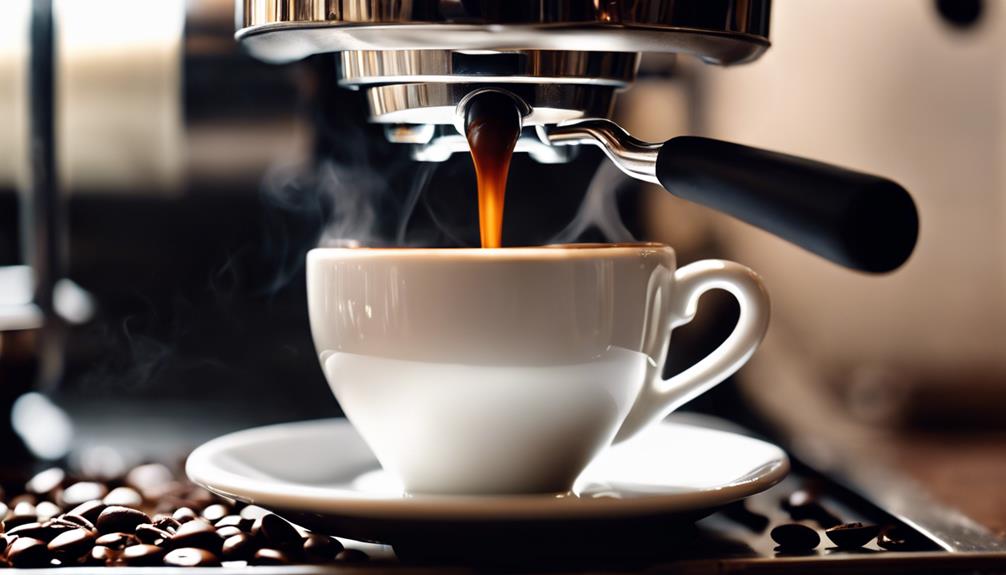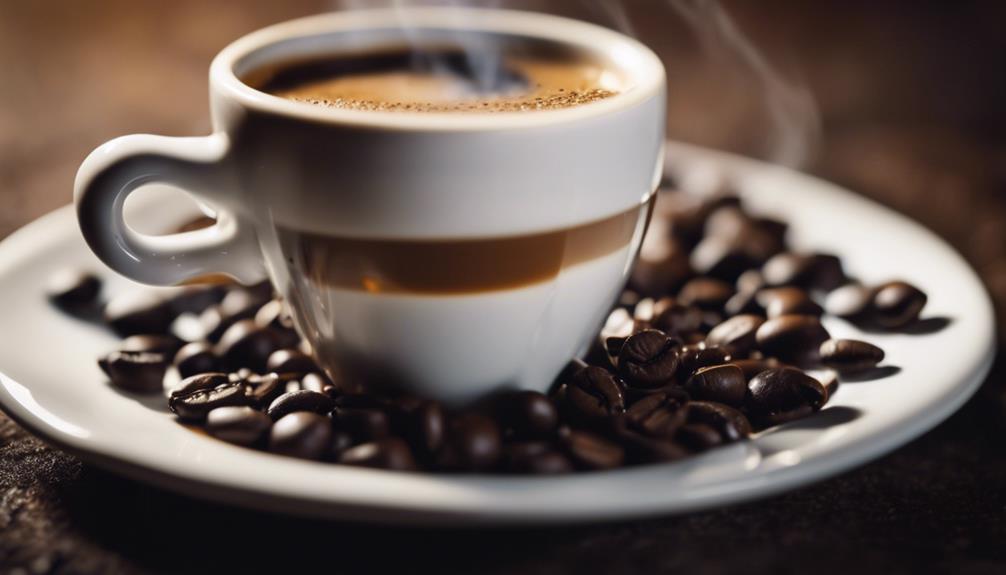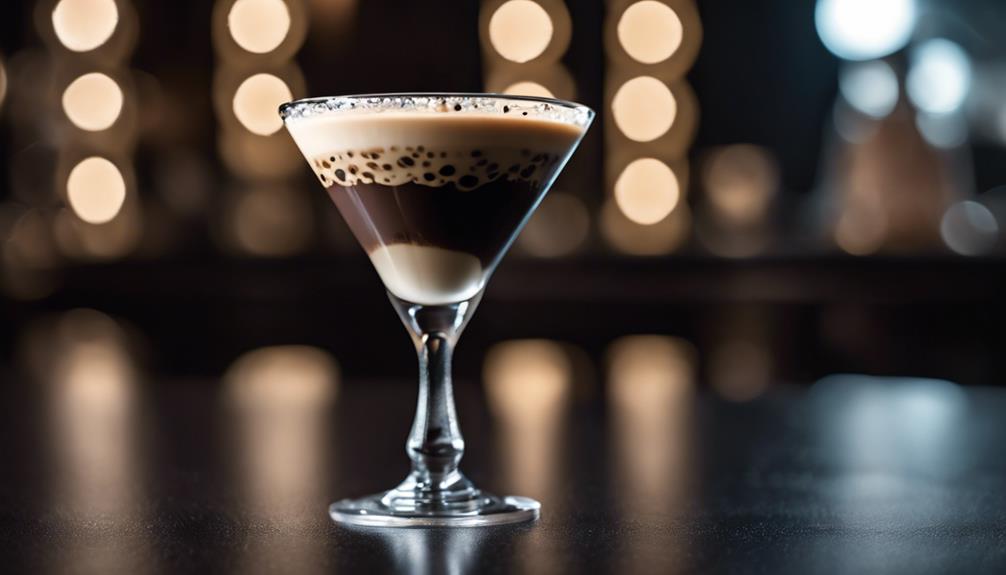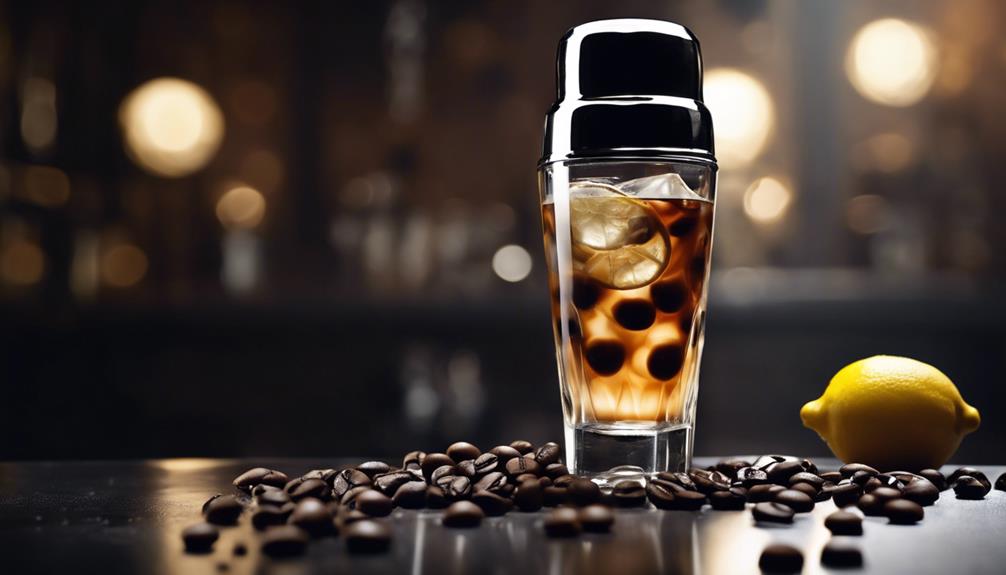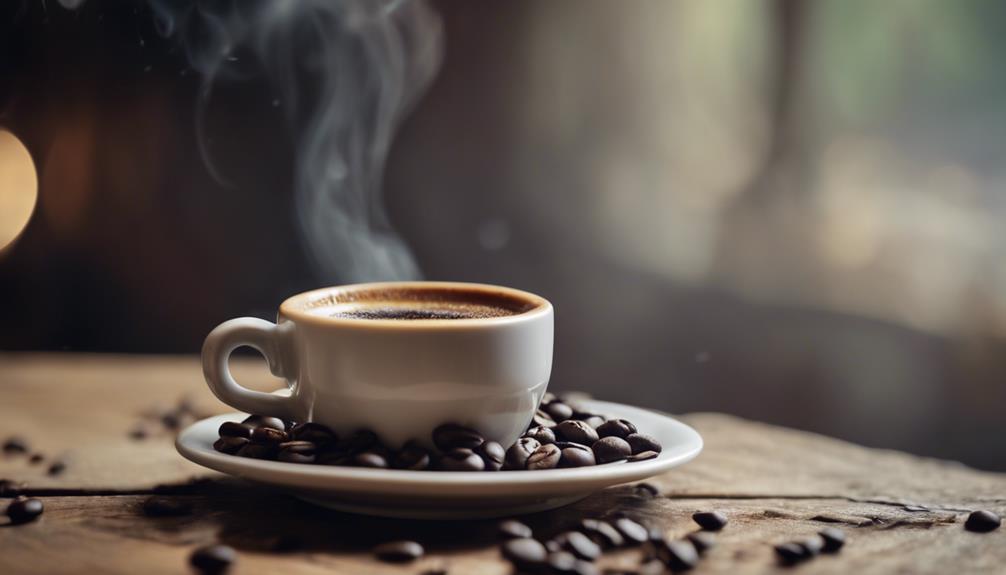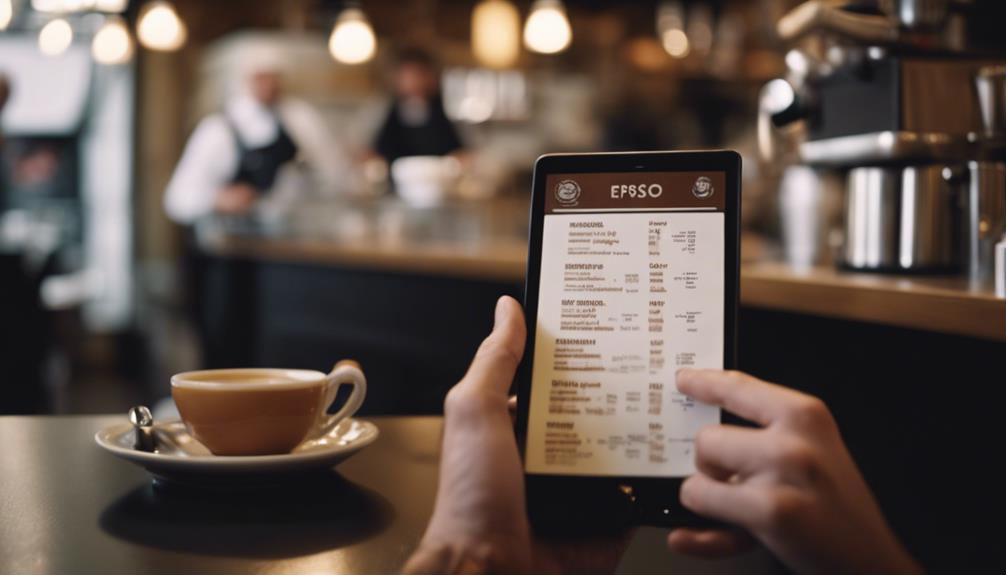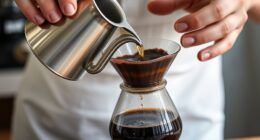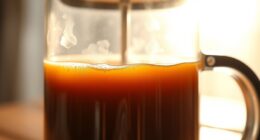When you enjoy a double espresso, you are treating yourself to a rich, complex flavor experience that is twice the fun! This traditional Italian coffee staple is made with precision, using 22 grams of coffee to create a harmonious blend of flavors. With approximately 80-120mg of caffeine, it is perfect for both experienced coffee enthusiasts and casual drinkers. As you delight in the thick, golden-brown crema and rich aroma, you will taste notes of chocolate, nuts, fruit, or flowers, depending on the coffee beans used. And there is more to discover – from regional variations to expert pairing options, your double espresso journey is just beginning!
Key Takeaways
- Doppio espresso is a double shot of espresso, symbolizing Italian coffee craftsmanship and the art of espresso extraction.
- With approximately 80-120mg of caffeine, doppio appeals to both seasoned coffee connoisseurs and casual drinkers.
- The rich aroma and flavor profile emerge with each sip, influenced by the choice of coffee beans and precise brewing processes.
- Experimentation with coffee dose, brew ratios, and grind size allows for customized flavor experiences and regional twists.
Origins of the Doppio Tradition
As you investigate the world of espresso, discovering the origins of the doppio tradition takes you back to Italy's rich coffee culture, where the term 'doppio' literally translates to 'double,' referring to a double shot of espresso that has become an integral part of the country's coffee heritage.
You'll find that the Italian term 'doppio' is deeply rooted in the nation's coffee culture, where espresso machines, invented in the late 19th century, played an essential role in its development and popularization. These machines allowed baristas to extract the perfect double shot, showcasing their skills and expertise.
As you explore further, you'll discover that the doppio became a symbol of Italian coffee craftsmanship, highlighting the art of espresso extraction and the expertise of baristas. The early 20th century saw the rise of espresso bars in Italy, where the doppio was commonly served, contributing to its global popularity in specialty coffee shops.
Today, the doppio has evolved into a benchmark for barista skills worldwide, particularly favored in coffee culture hubs like Melbourne and London.
Understanding Doppio Characteristics
As you explore the world of doppio espresso, you'll notice that the flavor profile is richer and more complex than a single shot.
You'll detect notes of chocolate, nuts, fruit, or flowers, depending on the coffee beans used, which will tantalize your taste buds.
What's more, the crema's velvety texture and rich aroma will further enhance your sensory experience.
Doppio Flavor Profile
When you take a sip of a doppio espresso, you're immediately struck by its rich aroma and intense, balanced flavor profile. As a coffee lover, you'll appreciate the complexity of flavors that unfold with each sip. The typical 60ml yield of a doppio allows for a more concentrated flavor experience, with notes that can range from chocolatey and nutty to fruity and floral, depending on the beans used.
The ideal brew ratio of 1:2, achieved by using 22 grams of ground coffee, plays a vital role in balancing the flavor profile. This ratio allows for an ideal extraction time, resulting in a harmonious blend of flavors.
With a doppio, you can expect a more robust caffeine experience, with around 80-120mg of caffeine per serving. Whether you're a seasoned coffee connoisseur or just looking to elevate your morning routine, the rich flavor profile of a doppio is sure to delight.
Rich Aroma Experience
You're immediately enveloped in a rich aroma experience when you bring the cup of doppio espresso to your nose, the scent of roasted coffee beans and subtle notes of chocolate and fruit teasing your senses.
The thick, golden-brown crema on top of your doppio plays a significant role in enhancing this aroma, adding a velvety texture that complements the flavors to come.
As you take your first sip, the aroma gives way to a complex flavor profile, with notes of chocolate, nuts, and fruit emerging depending on the type of coffee beans used and their roast level.
The brewing process, with its precise extraction time and ideal water temperature, guarantees that the flavors are balanced and the aroma is intense.
With a doppio, you can expect a more robust flavor experience than a traditional single shot, thanks to the double volume of coffee.
Crafting the Perfect Doppio Shot
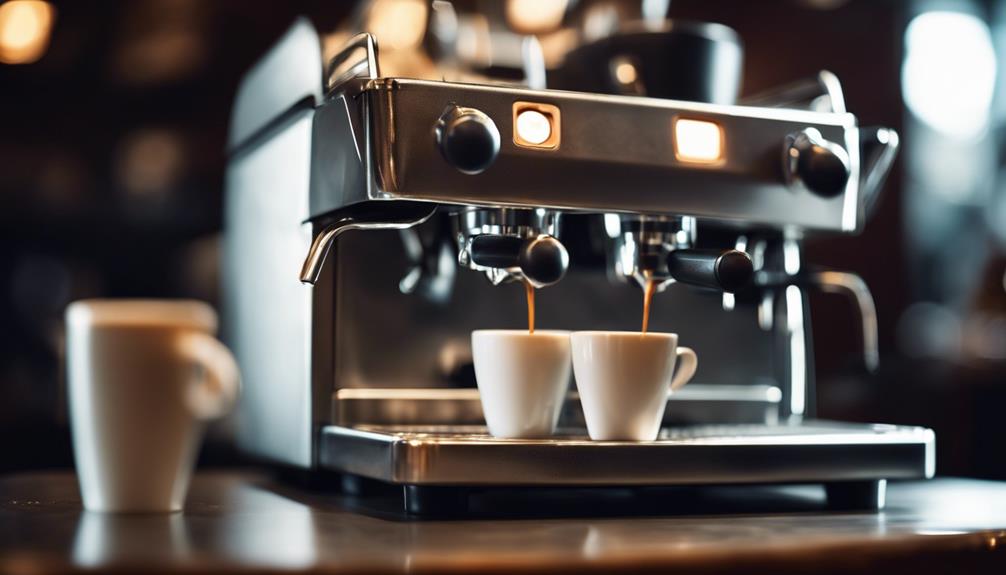
To craft the perfect doppio shot, start by using approximately 14 grams of finely ground coffee, which will yield about 60 ml of espresso and achieve an ideal brew ratio of 1:2 for rich flavor extraction.
This doppio espresso preparation requires attention to detail, so make certain you're using the right amount of coffee and grind size. A fine grind is essential for achieving the rich and full-bodied flavor characteristic of a doppio, so consider using a burr grinder for consistent results.
When tamping the coffee grounds in the portafilter, guarantee even pressure to prevent channeling, which can lead to uneven extraction and varying taste profiles between cups.
Extract the doppio shot within a time frame of 25-30 seconds, maintaining a water temperature between 195°F to 205°F for balanced flavor development.
Feel free to experiment with the coffee dose and brew ratios, ranging from 1:2.5 to 1:1.5, to customize the flavor profile and strength of your doppio shot according to your personal preference.
Exploring Doppio Variations
As you explore doppio variations, you'll discover that regional twists and personal preferences play a significant role in shaping the flavor profile.
You can experiment with customization options like grind size and brew ratios to create a doppio that suits your taste buds.
From traditional Italian-style doppio to unique recipes at specialty coffee shops, the possibilities are endless, and it's up to you to find your perfect cup.
Regional Doppio Twists
Across the globe, regional doppio twists offer a fascinating glimpse into local tastes and traditions, each putting its unique spin on the classic double shot. As you explore the world of doppio, you'll discover that regional customizations reflect the distinct flavors and preferences of each region.
In Italy, you'll experience the traditional doppio as a quick energy boost, served at the counter in a hurry. In contrast, the United States offers a more leisurely experience, serving the doppio in ceramic cups to savor the rich flavors. Meanwhile, Australia incorporates the doppio into flat whites or as a base for intricate coffee drinks, showcasing its versatility.
Some regional doppio twists you might encounter include:
- Doppio Romano: a twist of lemon adds a bright citrus note to the rich espresso flavor.
- Australian flat whites: the doppio serves as a base for a velvety, smooth coffee experience.
As you explore into the world of regional doppio twists, you'll find that each variation offers a unique espresso experience that's a true reflection of local coffee culture.
Customization Options
You can elevate your doppio experience by exploring various customization options, from flavorful twists to creative pairings, that cater to your unique tastes and preferences. Whether you're a coffee connoisseur or a casual enthusiast, there's a way to make your doppio truly yours.
| Customization Option | Description |
|---|---|
| Flavored Syrups | Add a drizzle of vanilla, hazelnut, or caramel to give your doppio a unique flavor profile |
| Specialty Coffee Beans | Experiment with different beans and roast levels to create a one-of-a-kind taste experience |
| Food Pairing | Pair your doppio with dark chocolate, biscotti, or savory pastries to elevate the tasting experience |
At specialty coffee shops, you can try variations like Doppio Romano, topped with a twist of lemon, or indulge in whipped cream for a sweeter treat. At home, you can experiment with different brewing methods and beans to create a customized doppio that suits your taste buds. Whatever your preference, there's a way to make your doppio experience truly unforgettable. So go ahead, get creative, and make your doppio a reflection of your unique style!
The Art of Doppio Pairing
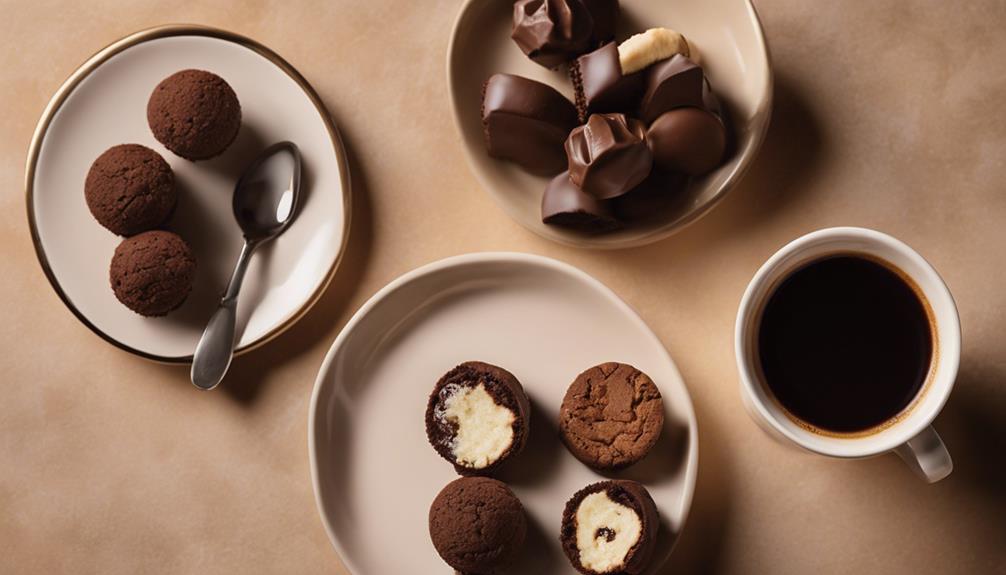
Pairing a doppio with the right food can elevate its rich flavors and create a harmonious balance of taste and texture. You're not limited to just one option, though – the beauty of doppio pairing lies in its versatility.
Try pairing your doppio with:
Dark chocolate, which enhances the espresso's robust flavors.
Fruity desserts like tarts or cakes, which contrast beautifully with the coffee's bitter notes.
Nuts like almonds or hazelnuts, which amplify the nutty flavor profiles often found in the espresso itself.
In Italian culture, it's common to savor a doppio with a pastry during breakfast, creating a delightful combination of flavors and textures.
You can also experiment with regional variations, like pairing a doppio with lemon in a Doppio Romano, which adds a revitalizing citrus twist to the robust espresso experience.
Doppio in Modern Coffee Culture
In the heart of modern coffee culture, the doppio has emerged as a benchmark for espresso quality, with its rich flavor profile and velvety texture enchanting coffee connoisseurs worldwide.
As you step into a specialty coffee shop, you're likely to find a doppio, or double shot, of espresso on the menu, yielding approximately 60 ml of intense flavor. This double shot has become a staple in modern coffee culture, symbolizing the rise of artisanal coffee shops and skilled baristas globally. Visitors can also enjoy the convenience of nespresso double espresso pods, which allow aficionados to recreate the same rich and robust experience at home. This accessibility speaks to the widespread appeal and demand for high-quality coffee, as well as the innovation within the industry. Whether sipping a doppio in a trendy coffee shop or brewing a double espresso at home, the double shot continues to define and elevate the coffee experience.
You can customize your doppio experience, with variations like the Doppio Romano, where a lemon peel is added, reflecting the trend towards innovative and personalized coffee experiences.
To prepare the perfect doppio, baristas carefully control grind sizes, tamping, and extraction time to guarantee consistent quality and flavor.
As coffee culture evolves, the doppio continues to gain popularity, serving as a benchmark for espresso quality and a preferred choice for those seeking a robust caffeine kick.
Mastering Doppio at Home
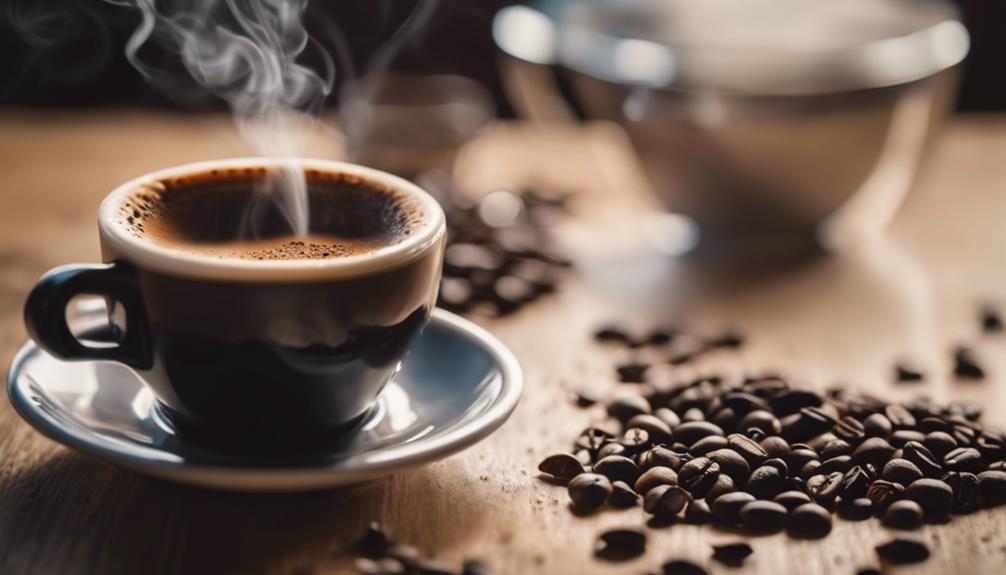
With a few key pieces of equipment and some practice, mastering the art of brewing a perfect doppio at home is within your reach.
You'll need a high-quality espresso machine, a burr grinder for consistent grind size, and a scale to measure approximately 14 grams of coffee for a double shot yielding around 60 ml of espresso.
To achieve peak extraction, make sure to tamp the coffee evenly in the portafilter and aim for a brew time of 25-30 seconds at a water temperature between 195°F and 205°F.
Here are some additional tips to enhance your doppio game:
- Experiment with grind size to find the sweet spot, as too fine may lead to bitterness and too coarse may result in weak espresso.
- Utilize techniques like the Weiss Distribution Technique (WDT) for even coffee distribution in the portafilter to prevent channeling and guarantee balanced extraction.
Frequently Asked Questions
What Is the Difference Between a Doppio and a Double Espresso?
You might wonder, what's the difference between a doppio and a double espresso? Well, surprisingly, there isn't one – both terms refer to a double shot of espresso, with about 60ml of coffee and a richer flavor profile.
What Does Double Espresso Mean in Nespresso?
When you hear "double espresso" in Nespresso, it means you're getting two shots of rich coffee extracted simultaneously, totaling around 60 ml, with a caffeine kick of 80-120 mg, depending on the blend.
Is Double Espresso the Strongest?
You're wondering if a double espresso is the strongest coffee drink out there. Not necessarily – while it packs a punch, drinks like espresso con panna or caffeinated coffee blends can actually surpass its intensity.
What Does Doppio Coffee Taste Like?
You're wondering what doppio coffee tastes like? Expect a rich, full-bodied flavor profile with notes of chocolate, nuts, fruit, and flowers, depending on the beans used, with a thick, velvety mouthfeel and fragrant aroma.
Conclusion
You've now revealed the secrets of the revered doppio espresso.
As you savor every rich, velvety sip, remember that Italians consume over 70 million doppio shots daily – that's enough to fill the Trevi Fountain twice!
With your newfound knowledge, you're ready to elevate your coffee game and join the ranks of doppio aficionados worldwide.
So go ahead, indulge in this decadent delight, and experience the thrill of double the flavor, double the fun!
